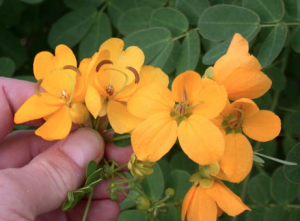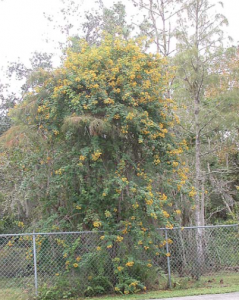Naples Daily News Dec. 6, 2008


Above: The earleaf acacia (Acacia auriculiformis) grows to 40 feet tall and has elongate leaves with parallel veins. Photo: Stephen Brown. UF/IFAS Lee Co. Extension.

Right, above: Compare the Christmas senna (Senna pendula ‘Glabrata’ ) on the left (the 2 flowers above thumb) with notched petals and handlebar moustache-like anthers with the glossy senna flowers, on the right half of the picture. Glaucous cassia (S. surattensis) lacks the outrageously long anthers, but has a green calyx which is visible at the base looking inside the flower and no deeply notched petals. Right: A Christmas senna scrambles into the canopies of cypress and pine trees.
Because they are in flower (Nov.-Dec.), now is a good time to identify some invasive plants which should be removed. Both of these species are on the FLEPPC (Florida Exotic Pest Plant Council) as a Category 1 threat. This means the plants are altering native plant communities by displacing native species and there are some other ecological impacts (see, www.fleppc.org ).
The first plant, the earleaf acacia (Acacia auriculiformis), is native to Australia. This one is easy to spot as it grows to 40 feet and the canopies are full of 2 to 3 inch long fuzzy yellow flower spikes. It is very attractive and as Frederic Stresau (Florida, My Eden) states (at one time), “The favorite tree of many land developers for its fantastic growth and rock bottom purchase price.” Too bad it is so invasive. It has unique leaves that are curved, blade-like, 4 to 6 inches long with parallel veins. This is a real fun leaf to quiz beginning botany students about which class of plants it belongs to… is it a monocot (parallel leaf veins)? or a dicot (net-like leaf vein pattern…usually!)? This dicot has leaves that break the normal rule. There are almost always exceptions to the rule in taxonomy! The seed pod of this legume is about 4 inches long, coiled and resembling (if you use your imagination) an ear.
Now, this next plant may be in use by butterfly enthusiasts who are (some are anyway) unaware of its invasiveness. I am seeing it pop up in some preserve areas around the Goodlette-Frank Road and Orange Blossom Drive areas. It is the Christmas senna (Senna pendula var. glabrata) and it is the bad species which needs to be avoided. This is sometimes referred to in the landscape and nursery trade as Cassia bicaspularis. Some common names include: Christmas senna, climbing cassia and butterfly cassia. This plant has, after a few years, an obvious clambering growth habit and will grow 15 to 20 feet into nearby trees. Other cassias do not have this climbing habit. However, if the Christmas senna is grown in the open, it will tend to remain shrubby.
If you desire the yellow flowers and the acrobatic flight of the yellow butterflies, Mike Malloy (aka “Captain Caterpillar” and a Florida Yards and Neighborhoods Extension educator), recommends these other Senna species: candlestick or candlelabra plant (S. alata)- beautiful large compound tropical looking leaves; popcorn senna (S. didymobotrya)-beautiful leaves and flowers with a wonderful popcorn fragrance, plus a fun to repeat species name- “didymobotrya”; and the species commonly seen in the roadway medians, glossy shower,aka, glaucous cassia (S. surattensis)- this one gets top heavy and blows over when nearby cars go by at 35 MPH- it needs constant thinning- but it is a long flowering prolific bloomer. There are several other senna which are shorter and more constrained in growth such as Chapman’s wild sensitive plant (S. Mexicana ‘Chapmanii’) and privet wild sensitive plant or Bahama cassia (S. ligustrina).
The easiest way to determine if you have the invasive Christmas senna is to look at the flower, it has bodacious, brown tipped anthers which curl upwards like a handlebar moustache. The petal above the brown moustache has a slight notch at the tip. It has compound leaves with 8 to 14 leaflets. The seed pod is a brown slender pod, cylindrical and 3 to 5 inches long.
The glossy shower or glaucous cassia has smaller anthers, a green area is visible at the base of the flower (looking into the flower) and its compound leaves have 6 to 10 blunt-oval leaflets up to 2 inches long. Seed pods are 6 inches long and 2 1⁄2 inches wide and indented between seeds.
So go out and take a stab at identifying some of these yellow flowering plants in your neighborhood. It is fun and you may find you have some plants that need to be removed.
Doug Caldwell, Ph.D., is the Commercial Landscape Horticulture Extension Educator with the University of Florida Collier County Extension. The Extension Service is an off-campus branch of the University of Florida, Institute of the Food and Agricultural Sciences and a department of the Public Services Division of Collier County government. E-Mail dougbug@.ufl.edu ; call (239) 353-4244 ext. 203. Extension programs are open to all persons without regard to race, color, creed, sex handicap or national origin.
 0
0
